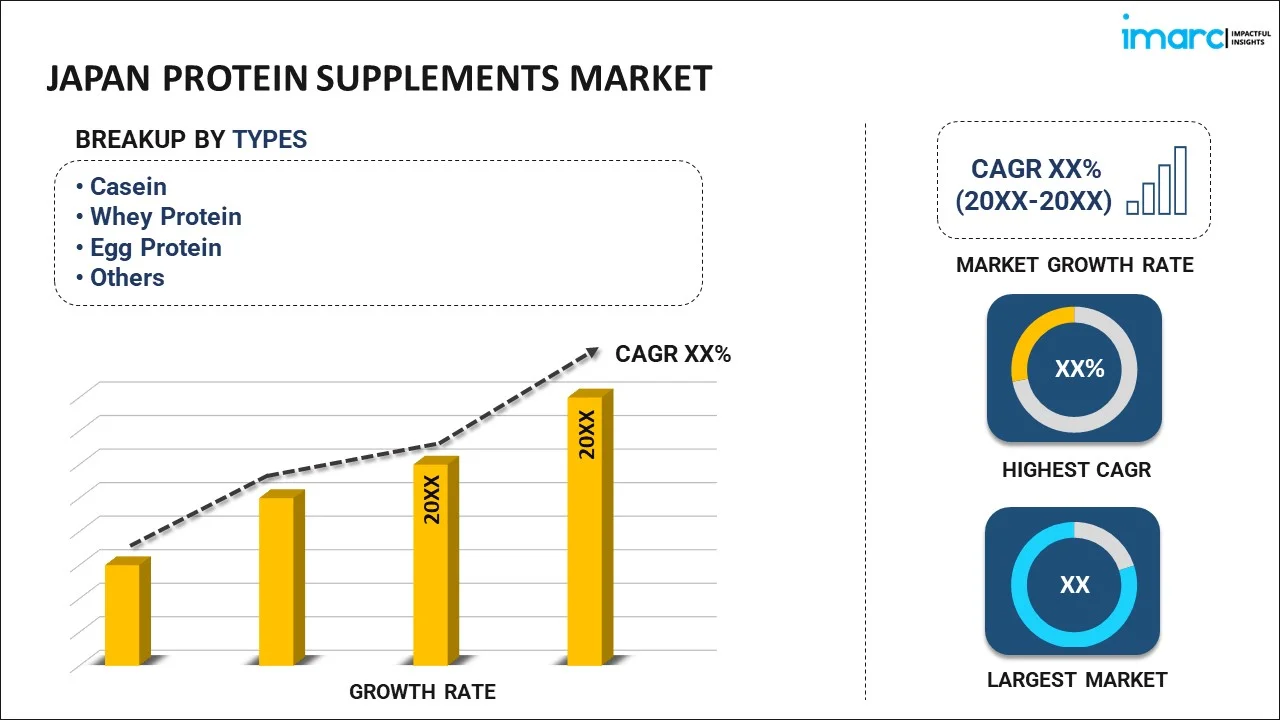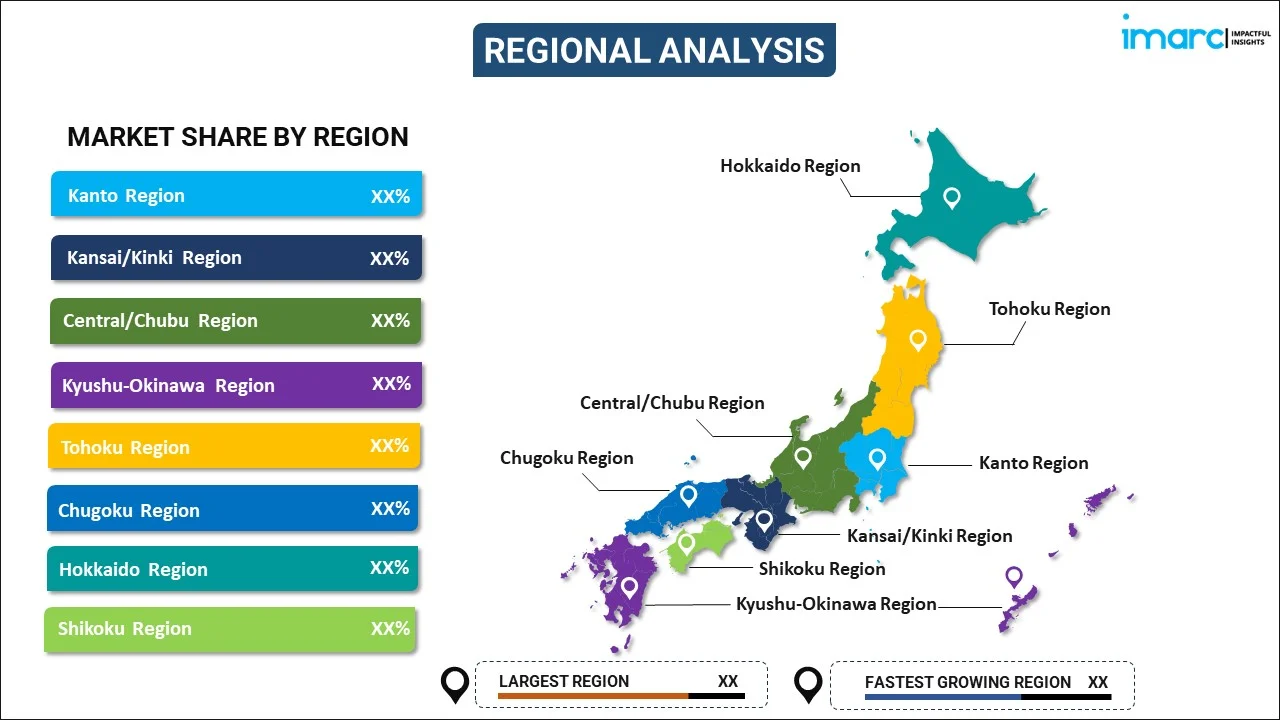
Japan Protein Supplements Market Report by Type (Casein, Whey Protein, Egg Protein, Soy Protein, and Others), Form (Protein Powder, Protein Bars, Ready to Drink, and Others), Source (Animal-Based, Plant-Based), Application (Sports Nutrition, Functional Food), Distribution Channel (Supermarkets and Hypermarkets, Online Stores, Direct to Customers (DTC), and Others), and Region 2025-2033
Market Overview:
Japan protein supplements market size reached USD 1,549 Million in 2024. Looking forward, IMARC Group expects the market to reach USD 3,065 Million by 2033, exhibiting a growth rate (CAGR) of 7.9% during 2025-2033. The increasing consumption of nutritional supplements in daily routines to preserve overall health, along with the growing importance of protein in maintaining muscle mass and strength, is driving the market.
|
Report Attribute
|
Key Statistics
|
|---|---|
|
Base Year
|
2024 |
|
Forecast Years
|
2025-2033
|
|
Historical Years
|
2019-2024
|
| Market Size in 2024 | USD 1,549 Million |
| Market Forecast in 2033 | USD 3,065 Million |
| Market Growth Rate (2025-2033) | 7.9% |
Protein supplements are dietary products designed to provide an additional source of protein for individuals who may have difficulty meeting their protein needs through regular food consumption. They typically come in the form of powders, shakes, bars, or capsules. Protein is essential for various bodily functions, including muscle growth and repair, immune system support, and enzyme production. People often turn to protein supplements for various reasons, such as athletes aiming to enhance their muscle recovery and performance, individuals on weight loss diets to maintain muscle mass, or those with dietary restrictions like vegetarians and vegans who may struggle to meet their protein requirements. Whey, casein, soy, and pea protein are common sources found in these supplements. While protein supplements can be convenient and effective, it's essential to use them as part of a balanced diet rather than relying solely on them for nutrition. It's also crucial to consult with a healthcare professional before starting any supplementation regimen to ensure it aligns with specific health goals and needs.
Japan Protein Supplements Market Trends:
The protein supplements market in Japan has experienced robust growth in recent years, primarily driven by several key factors. To begin with, the increasing emphasis on health and fitness among the regional population has been a pivotal catalyst for this industry's expansion. Furthermore, as consumers become more health-conscious, they are increasingly recognizing the importance of protein in their diets, propelling the demand for supplements. Additionally, the growing trend of vegetarian and vegan diets has fueled the need for plant-based protein supplements, addressing a niche market within the broader industry. Moreover, the rise in awareness about the benefits of protein supplements in muscle recovery and weight management has led to a surge in consumer interest. Furthermore, the convenience factor associated with protein supplements has played a pivotal role in market growth. Consumers often find it easier to incorporate protein shakes or bars into their daily routines, especially in today's fast-paced lifestyles. Lastly, the expansion of e-commerce and digital marketing channels, which has made it easier for consumers to access a wide range of protein supplements, is expected to drive the market in Japan during the forecast period.
Japan Protein Supplements Market Segmentation:
IMARC Group provides an analysis of the key trends in each segment of the market, along with forecasts at the country level for 2025-2033. Our report has categorized the market based on type, form, source, application, and distribution channel.
Type Insights:

- Casein
- Whey Protein
- Egg Protein
- Soy Protein
- Others
The report has provided a detailed breakup and analysis of the market based on the type. This includes casein, whey protein, egg protein, soy protein, and others.
Form Insights:
- Protein Powder
- Protein Bars
- Ready to Drink
- Others
A detailed breakup and analysis of the market based on the form have also been provided in the report. This includes protein powder, protein bars, ready to drink, and others.
Source Insights:
- Animal-Based
- Plant-Based
The report has provided a detailed breakup and analysis of the market based on the source. This includes animal-based and plant-based.
Application Insights:
- Sports Nutrition
- Functional Food
A detailed breakup and analysis of the market based on the application have also been provided in the report. This includes sports nutrition and functional food.
Distribution Channel Insights:
- Supermarkets and Hypermarkets
- Online Stores
- Direct to Customers (DTC)
- Others
The report has provided a detailed breakup and analysis of the market based on the distribution channel. This includes supermarkets and hypermarkets, online stores, direct to customers (DTC), and others.
Regional Insights:

- Kanto Region
- Kansai/Kinki Region
- Central/ Chubu Region
- Kyushu-Okinawa Region
- Tohoku Region
- Chugoku Region
- Hokkaido Region
- Shikoku Region
The report has also provided a comprehensive analysis of all the major regional markets, which include Kanto Region, Kansai/Kinki Region, Central/ Chubu Region, Kyushu-Okinawa Region, Tohoku Region, Chugoku Region, Hokkaido Region, and Shikoku Region.
Competitive Landscape:
The market research report has also provided a comprehensive analysis of the competitive landscape in the market. Competitive analysis such as market structure, key player positioning, top winning strategies, competitive dashboard, and company evaluation quadrant has been covered in the report. Also, detailed profiles of all major companies have been provided.
Japan Protein Supplements Market Report Coverage:
| Report Features | Details |
|---|---|
| Base Year of the Analysis | 2024 |
| Historical Period | 2019-2024 |
| Forecast Period | 2025-2033 |
| Units | Million USD |
| Scope of the Report | Exploration of Historical Trends and Market Outlook, Industry Catalysts and Challenges, Segment-Wise Historical and Future Market Assessment:
|
| Types Covered | Casein, Whey Protein, Egg Protein, Soy Protein, Others |
| Forms Covered | Protein Powder, Protein Bars, Ready to Drink, Others |
| Sources Covered | Animal-Based, Plant-Based |
| Applications Covered | Sports Nutrition, Functional Food |
| Distribution Channels Covered | Supermarkets and Hypermarkets, Online Stores, Direct to Customers (DTC), Others |
| Regions Covered | Regions Covered Kanto Region, Kansai/Kinki Region, Central/ Chubu Region, Kyushu-Okinawa Region, Tohoku Region, Chugoku Region, Hokkaido Region, Shikoku Region |
| Customization Scope | 10% Free Customization |
| Post-Sale Analyst Support | 10-12 Weeks |
| Delivery Format | PDF and Excel through Email (We can also provide the editable version of the report in PPT/Word format on special request) |
Key Questions Answered in This Report:
- How has the Japan protein supplements market performed so far and how will it perform in the coming years?
- What has been the impact of COVID-19 on the Japan protein supplements market?
- What is the breakup of the Japan protein supplements market on the basis of type?
- What is the breakup of the Japan protein supplements market on the basis of form?
- What is the breakup of the Japan protein supplements market on the basis of source?
- What is the breakup of the Japan protein supplements market on the basis of application?
- What is the breakup of the Japan protein supplements market on the basis of distribution channel?
- What are the various stages in the value chain of the Japan protein supplements market?
- What are the key driving factors and challenges in the Japan protein supplements?
- What is the structure of the Japan protein supplements market and who are the key players?
- What is the degree of competition in the Japan protein supplements market?
Key Benefits for Stakeholders:
- IMARC’s industry report offers a comprehensive quantitative analysis of various market segments, historical and current market trends, market forecasts, and dynamics of the Japan protein supplements market from 2019-2033.
- The research report provides the latest information on the market drivers, challenges, and opportunities in the Japan protein supplements market.
- Porter's five forces analysis assist stakeholders in assessing the impact of new entrants, competitive rivalry, supplier power, buyer power, and the threat of substitution. It helps stakeholders to analyze the level of competition within the Japan protein supplements industry and its attractiveness.
- Competitive landscape allows stakeholders to understand their competitive environment and provides an insight into the current positions of key players in the market.
Need more help?
- Speak to our experienced analysts for insights on the current market scenarios.
- Include additional segments and countries to customize the report as per your requirement.
- Gain an unparalleled competitive advantage in your domain by understanding how to utilize the report and positively impacting your operations and revenue.
- For further assistance, please connect with our analysts.
 Inquire Before Buying
Inquire Before Buying
 Speak to an Analyst
Speak to an Analyst
 Request Brochure
Request Brochure
 Request Customization
Request Customization




.webp)




.webp)












